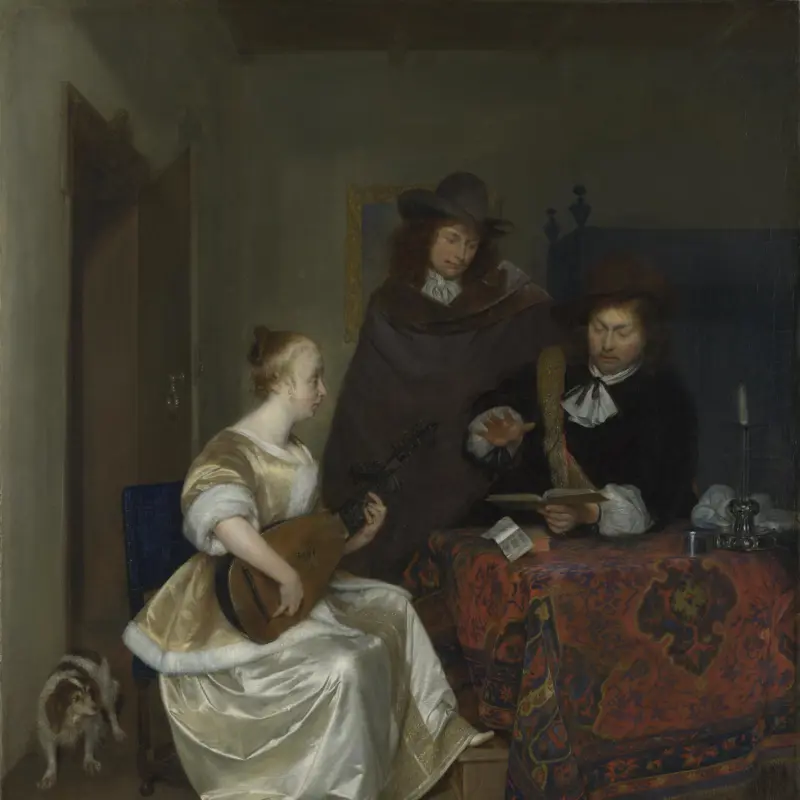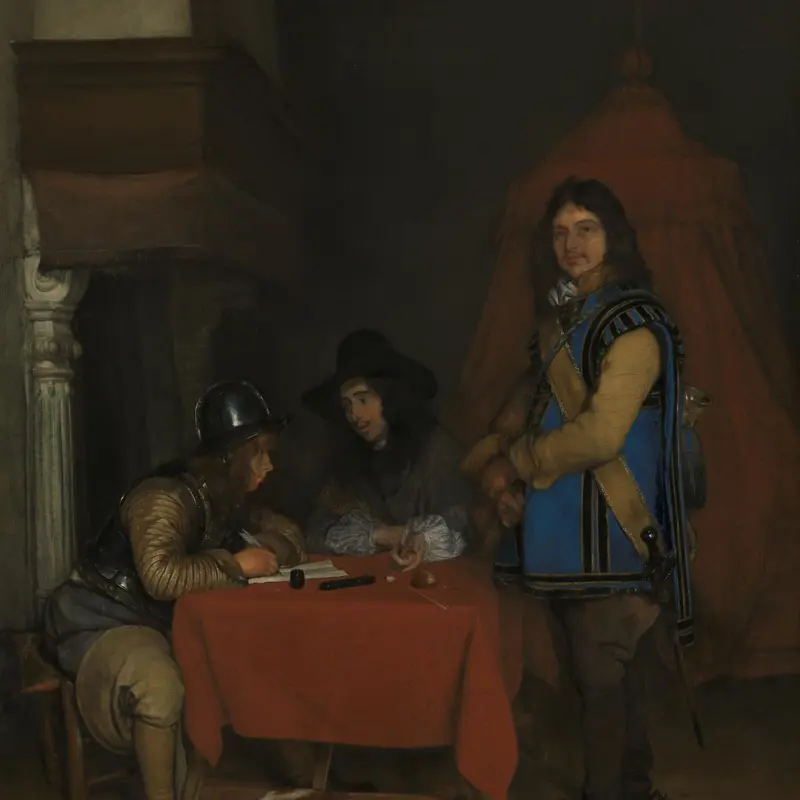Gerard ter Borch, 'Portrait of a Young Man', about 1663
About the work
Overview
In the early 1660s, when this portrait was made, this fancy outfit, bedecked with ruffles, ribbons and lace, was the height of sophisticated dressing, inspired by the latest fashions in Paris and employing the most expensive fabrics and tailoring.
We don’t know who the sitter is, though it seems almost certain that he was a wealthy burgher from the Dutch town of Deventer where ter Borch had settled in 1654. He was certainly a man of status, upright and conscious of demonstrating his social and financial status.
And he was apparently not afraid to alienate some of his more conservative contemporaries. Such ostentatious dressing was not universally approved of in the Netherlands at the time. Stricter Calvinists (who followed Calvinism, a branch of Protestantism) would certainly have raised their eyebrows at what one contemporary writer referred to as ‘immoderately loose and long garments… redolent of over-abundance and profligacy’.
Key facts
Details
- Full title
- Portrait of a Young Man
- Artist
- Gerard ter Borch
- Artist dates
- 1617 - 1681
- Date made
- about 1663
- Medium and support
- oil on canvas
- Dimensions
- 67.3 × 54.3 cm
- Acquisition credit
- Bought, 1894
- Inventory number
- NG1399
- Location
- Not on display
- Collection
- Main Collection
Provenance
Additional information
Text extracted from the ‘Provenance’ section of the catalogue entry in Neil MacLaren, revised and expanded by Christopher Brown, ‘National Gallery Catalogues: The Dutch School: 1600–1900’, London 1991; for further information, see the full catalogue entry.
Exhibition history
-
2012In Pursuit of Art: Charles Eastlake’s Journey from Plymouth to the National GalleryPlymouth City Museum and Art Gallery22 September 2012 - 15 December 2012
Bibliography
-
1846Hours in Lord Northwick's Picture Galleries, Cheltenham 1846
-
1854G.F. Waagen, Treasures of Art in Great Britain: Being and Account of the Chief Collections of Paintings, Drawings, Sculptures, Illuminated Mss. […], vol. 2, trans. E. Eastlake, London 1854
-
1907C. Hofstede de Groot, Catalogue Raisonné of the Works of the Most Eminent Dutch Painters of the Seventeenth Century, 10 vols, London 1907
-
1907C. Hofstede de Groot, Catalogue Raisonné of the Works of the Most Eminent Dutch Painters of the Seventeenth Century, 10 vols, London 1907
-
1960Maclaren, Neil, National Gallery Catalogues: The Dutch School, 2 vols, London 1960
-
1983J. Mills and R. White, 'Pictures Cleaned and Restored in the Conservation Department of the National Gallery, January 1982 – December 1982', National Gallery Technical Bulletin, VII, 1983
-
1983M. Levey, The Neglected National Gallery: An Exhibition of Paintings from the Lower Floor (exh. cat. The National Gallery, 20 April - 31 May 1983), London 1983
-
1991Maclaren, Neil, revised by Christopher Brown, National Gallery Catalogues: The Dutch School, 1600-1900, 2nd edn (revised and expanded), 2 vols, London 1991
-
1997A.M. Kettering, 'Gentlemen in Satin: Masculine Ideals in Later Seventeenth-Century Dutch Portraiture', Art Journal, LVI/2, 1997, pp. 41-7
-
1999A.M. Kettering, 'Gerard ter Borch's Portraits for the Deventer Elite', Simiolus, XXVII/1-2, 1999, pp. 46-69
-
2001
C. Baker and T. Henry, The National Gallery: Complete Illustrated Catalogue, London 2001
-
2002O. Bradbury and N. Penny, 'The Picture Collecting of Lord Northwick: Part II' The Burlington Magazine, CXLIV/1195, October 2002, pp. 606-17
-
2004A.K. Wheelock et al., Gerard ter Borch (exh. cat. National Gallery of Art, Washington, 7 November 2004 - 30 January 30 2005; Detroit Institute of Arts, 27 February - 22 May 2005), New York 2004
-
2007R. Ekkart and Q. Buvelot, Dutch Portraits: The Age of Rembrandt and Frans Hals (exh. cat. The National Gallery, 27 June - 16 September 2007; Mauritshuis, 13 October 2007 - 13 January 2008), London 2007
About this record
If you know more about this work or have spotted an error, please contact us. Please note that exhibition histories are listed from 2009 onwards. Bibliographies may not be complete; more comprehensive information is available in the National Gallery Library.




